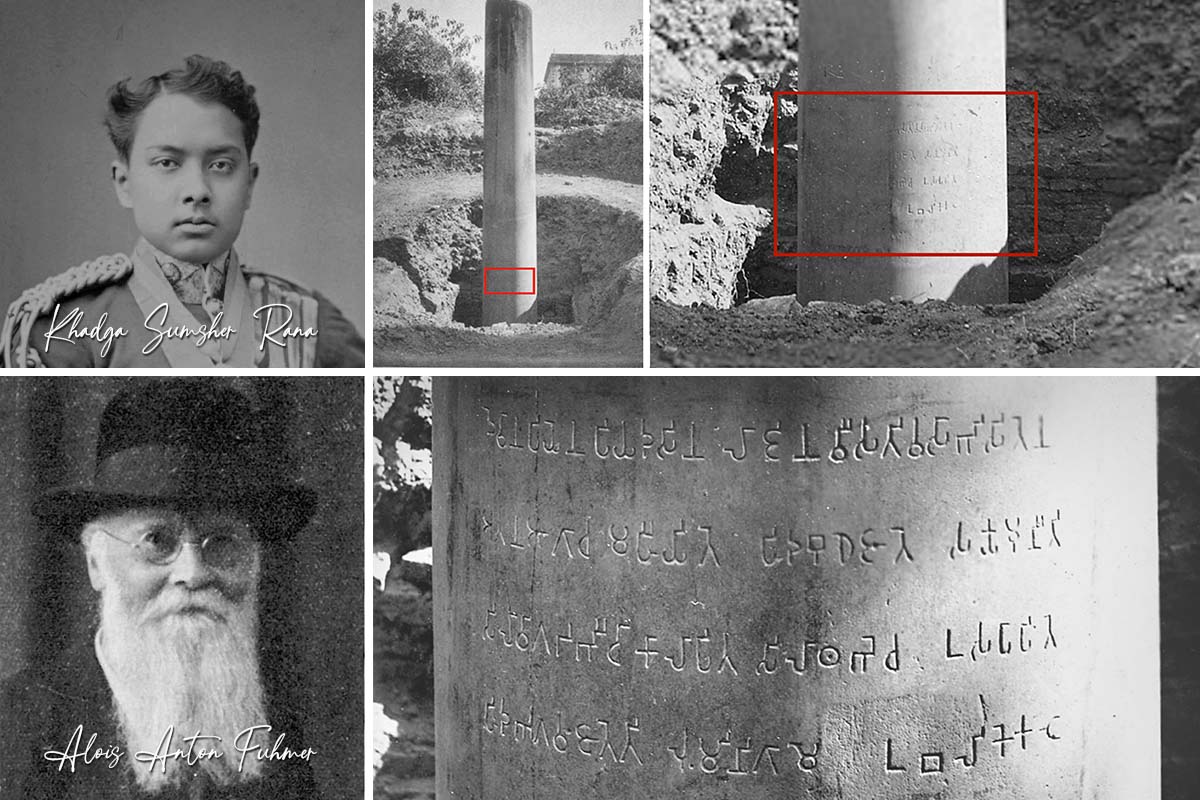The Legend of Buddha’s Birthplace
For more than two millennia, Buddhist tradition has taught that Queen Mayadevi gave birth to Siddhartha under a sal tree. According to the Buddhist textbooks, the newborn took seven symbolic steps immediately after his birth. These stories held immense spiritual significance, even though the exact location of his birth had long been lost beneath the dense forest and time.

Clues That Led to the Rediscovery
The rediscovery of Lumbini wasn’t a single moment of luck; it emerged slowly through several scattered clues. One important clue emerged in the late 19th century when an Indian Army officer, Duskaran Singh, came across a stone slab with ancient writing while hunting in the deep forests of the Terai. Although he couldn’t read the script, the find sparked curiosity among locals and later drew scholars and officials to the region.
Long before this discovery, however, ancient travel records had already pointed toward Lumbini’s location. Historically, in the early 4th century, Chinese monk Fa-Hien wrote about a sacred site associated with the Buddha’s nativity in his travel accounts, Fo-Kwo-Ki. Similarly, two hundred years later, a Chinese pilgrim, Xuanzang, also visited the same region and recorded that many of the monuments connected to Buddha’s birth were already in ruins and that the site’s popularity had begun to decline.
These early travel accounts, combined with local findings like the stone slab, helped create a trail of clues that eventually led to one of the most significant archaeological confirmations in Buddhist history.
The 1896 Discovery That Confirmed Lumbini
Although the Archeological Survey of India (ASI) had found significant evidence of Buddha’s existence in India, like Bodh Gaya, Sarnath, and Kushinagar (Buddha’s meditation sites), the birthplace of Buddha, was still unknown.
Following the growing clues about Buddha’s birthplace, the Archaeological Survey of India (ASI) appointed Alois Anton Führer to investigate the region. At that time, Nepal was under the Rana regime, and anyone entering the country required strict authorization. The ASI formally sent a letter to the then Prime Minister Bir Sumsher Rana, requesting permission to search for and excavate cultural and archaeological sites associated with Gautam Buddha. Bir Sumsher approved the request and entrusted the responsibility to his brother, Khadga Sumsher Jung Bahadur Rana, who then played a decisive role in the discovery. In 1953 BS, even before Führer arrived in Lumbini, Khadga Sumsher had already begun surveying the area and uncovered a partially buried stone pillar, the very pillar we now recognize as the Ashoka Pillar.

During excavation, an inscription was discovered on the exposed section of the pillar. Because the excavation was done without proper archaeological methods, the upper portion of the pillar was damaged, and it had to be restored later using metal strips. The inscription was written in the ancient Brahmi script, which neither Khadga Sumsher nor Alois Anton Führer could understand at the time. Once scholars later deciphered it, the text revealed a message from Emperor Ashoka himself: “King Piyadasi (Ashoka), beloved of the gods, in the 29th year of his coronation, visited Lumbini and paid homage. Realizing that the Blessed One was born here, he exempted the people of the village from taxes and granted them only an eighth share.”
In essence, Ashoka confirmed the exact birthplace of Lord Buddha by erecting the pillar and granting the locals a tax-free status. It was this inscription that ultimately provided undeniable historical proof of the birthplace of Gautam Buddha.
After the revelation, extensive excavations began in Lumbini, uncovering layers of history long hidden for centuries. Archaeologists found ancient brick foundations beneath the modern Maya Devi Temple, along with monasteries and stupas that traced the evolution of Buddhist worship over time. One of the most significant discoveries was the Marker Stone, which pinpoints the exact spot where Siddhartha Gautama is believed to have been born. Excavations also revealed ruins of early Buddhist structures and the sacred Puskarini Pond, where Queen Mayadevi is said to have bathed before giving birth. Together, these findings confirmed Lumbini as one of the earliest and most important Buddhist pilgrimage sites.
The Sacred Geography of Lumbini
Lumbini today is organized into three major zones, forming a peaceful and highly symbolic landscape:
1. The Sacred Garden (Birthplace Zone)
This area includes the Maya Devi Temple, the Ashoka Pillar, and archaeological ruins dating back more than 2,000 years. The ambiance is serene, with ancient trees and prayer flags adorning the pathways.
2. The Monastic Zone
Monasteries from around the world, including Thailand, Myanmar, Sri Lanka, Japan, China, and Germany, are built here, each of them showcasing its country’s architectural and spiritual traditions. The international monastic presence makes Lumbini a global hub for meditation and Buddhist study.

3. The Cultural and Development Zone
This section contains the Lumbini Museum, research centers, meditation facilities, and visitor accommodations, making it the outreach and educational center of the site.
Kenzo Tange’s Vision for Modern Lumbini
In 1978, Japanese architect Kenzo Tange created the Lumbini Master Plan, which guides development and conservation efforts even today. The plan emphasizes:
- Protected sacred spaces
- Calm walking paths
- Meditative areas
- Separation of sacred areas from commercial activity
Thanks to this thoughtful design, Lumbini maintains a balance between accessibility and tranquility.
Why Lumbini Matters Today
Lumbini is a universal symbol of peace, compassion, and mindfulness. It resonates with values that continue to inspire millions globally. Every year, monks, scholars, and spiritual seekers travel from across the globe to this sacred site to participate in meditation retreats, cultural exchanges, and learning programs that keep the teachings of the Buddha alive. Unlike a static historical site, Lumbini is a living heritage space where ancient history and spiritual practice exist side by side. The sacred ruins, temples, and the Maya Devi Temple preserve its rich past, while vibrant monastic communities and meditation centers continue to thrive as a stimulus for spiritual growth. This unique combination of historical significance, spiritual energy, and ongoing cultural activity makes Lumbini not only a must-visit pilgrimage site but also a timeless sanctuary for those seeking peace and reflection.
Must-Visit Places in Lumbini
For anyone planning to explore Lumbini, these landmarks are essential:
- Maya Devi Temple houses the birthplace marker
- Ashoka Pillar, a historical proof of Buddha’s birthplace
- Puskarini Pond, a serene, sacred waterbody
- World Peace Pagoda, built for global harmony
- International Monasteries, diverse architectural and spiritual expressions
- Lumbini Museum, a deeper look into Buddhist history
Each of these experiences adds a new layer to understanding the significance of Lumbini.
Best Time to Visit Lumbini
The ideal months to visit are October to April, when the weather is cooler and more pleasant. Lumbini becomes particularly vibrant during Buddha Jayanti (April/May), when pilgrims, monks, and visitors gather to celebrate the Buddha’s birth with prayers, processions, and candlelit ceremonies.
How to Get to Lumbini
Lumbini lies in the Rupandehi District of Nepal. The nearest airport is Gautam Buddha International Airport in Bhairahawa, just about a 30-minute drive from the sacred site. Road travel is also convenient from Kathmandu, Pokhara, and Chitwan.

Lumbini Today
Lumbini has grown into a center for peace research, cultural dialogue, and spiritual learning. Conservation efforts continue to protect the archaeological remains, while international collaborations help maintain the site’s global significance. The essence of Lumbini, however, remains unchanged. Lumbini is a place where visitors feel a connection to a story that began more than 2,600 years ago.

Final Thoughts
Walking through Lumbini feels like stepping into a timeless sanctuary. The serenity that surrounds the ancient foundations reminds you that this is where the journey of peace, compassion, and inner transformation began. Lumbini is a place where the message of peace was first born, and it continues to resonate across the world.


.jpg)





